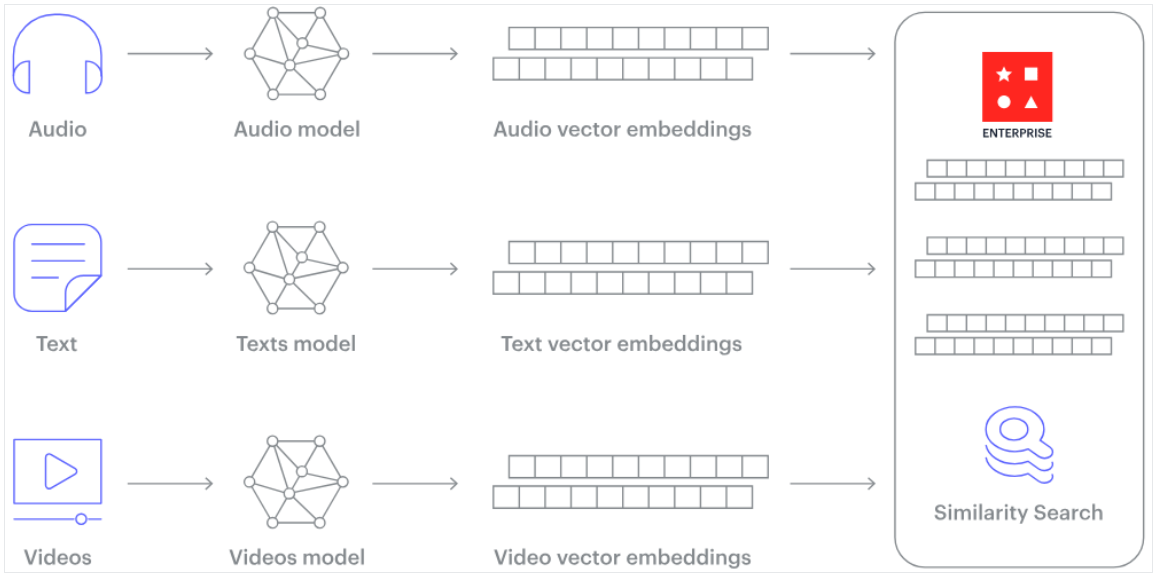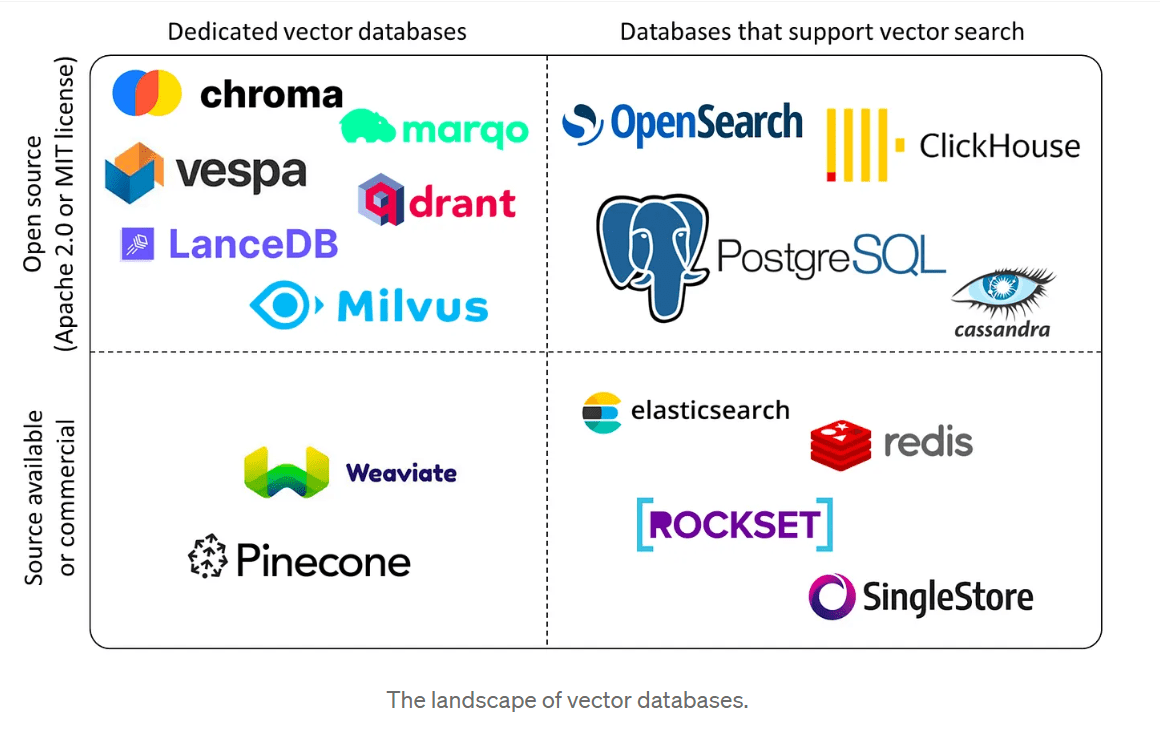Last updated on November 6th, 2023 at 07:56 pm
Insights Index
ToggleVector Databases: Transforming AI with High-Dimensional Data Management
Explore the impact of vector databases in AI. Discover their efficiency in managing multi-dimensional data. Learn their applications in retail, finance, healthcare, and security.
What is a Vector Database?
A vector database is a specialized storage system for unstructured data, like text, images, or audio, represented as vector embeddings. These embeddings, high-dimensional vectors, enable swift search and retrieval of similar items. Crucial for managing large datasets, vector databases offer scalability and efficiency.
They can handle high-dimensional vector embeddings generated by AI models, which are complex to manage due to their numerous attributes. Utilized in applications such as image and text search, recommendation systems, and anomaly detection, vector databases streamline data processing and retrieval.
Some examples of vector databases include Chroma , Pinecone, Milvus, Vespa, Marqo, Weaviate, Qdrant, and Faiss.
Credit: Demo Video by Fireship.
Why is it Important?
Vector databases are crucial in AI applications where data complexity is paramount. They enable efficient storage, retrieval, and analysis of multi-dimensional data, allowing AI systems to process vast amounts of information rapidly. This efficiency is vital for tasks like image recognition, recommendation systems, and natural language processing.
Where is it Used?
Vector databases are utilized in various sectors such as retail, finance, healthcare, media analysis, and security. In retail, they power personalized shopping experiences and recommendation systems. In finance, they aid in pattern detection and enable informed investment strategies.
In healthcare, these databases facilitate tailored medical treatments based on genomic analysis. For media analysis, they enhance image and video understanding across multiple applications. Additionally, in the realm of security, vector databases play a vital role in efficient fraud detection and implementing robust security measures.
When is it Utilized?
Vector databases are used whenever there is a need to handle large volumes of complex data in real-time. With the rise of AI technologies, their usage has become prevalent, especially in modern AI-driven applications developed for tasks ranging from customer interactions to scientific research.
How does it Work?
Vector databases leverage techniques like embeddings and Approximate Nearest Neighbor (ANN) search. Embeddings transform diverse data into numerical representations, making them suitable for analysis. ANN search algorithms then efficiently find similar vectors, allowing quick and precise data retrieval, a crucial aspect in AI applications.

Converting input in to Vector Embeddings (Image Source)
Real world applications of Vector databases
Vector databases, a technological marvel, are reshaping our digital landscape. Here’s how:
Personalized Shopping: Imagine online stores knowing exactly what you want. Vector databases power personalized recommendations, enabling tailored shopping experiences based on your preferences and past choices.
Financial Insights: In the financial world, predicting market trends is crucial. Vector databases aid in the analysis of vast datasets, unveiling patterns within stock prices and market behavior. They empower financial institutions to make informed decisions.
Smart Healthcare: Hospitals leverage vector databases to understand patient data better. By identifying patterns, they assist in precise diagnoses and personalized treatment plans. It’s like having a medical expert analyze every detail of your health.
Smarter Conversations: Ever wondered how chatbots understand your questions so well? Vector databases enable them to process language intricacies, ensuring accurate and efficient responses. It’s akin to having a knowledgeable friend at your fingertips.
Image Sleuths: For industries relying on images, like art or design, vector databases are game-changers. They facilitate the swift identification of similar images, streamlining tasks like sorting vast photo collections or detecting duplicates.
Spotting Anomalies: Detecting unusual patterns is vital, especially in banking or cybersecurity. Vector databases help in spotting anomalies, like fraudulent transactions, ensuring your money stays safe.
Entertainment Tailored for You: Ever wondered how streaming services recommend movies you love? It’s all thanks to vector databases, which aid in analyzing your watching habits and suggest content tailored just for you.
In essence, vector databases are the secret sauce behind many technologies we use daily. They facilitate in transforming raw data into meaningful insights, making our digital experiences smarter, safer, and more enjoyable.
Applications of Vector Databases in the context of Generative AI
In the realm of generative AI, vector databases stand as pivotal tools, enabling seamless operations and unlocking new horizons. Here’s how they make a difference:
Accelerated Training: Vector databases streamline data structuring, dramatically reducing the time needed for generative AI training. This efficiency translates to productivity gains, enhancing overall workflow speed.
Revolutionizing Data Search: During the age of generative AI, the way we search for data changes. Vector databases emerge as powerful engines, adept at managing unstructured data types—text, audio, images, and videos. Their numerical form simplifies search and analysis, revolutionizing data discovery.
Empowering Large Language Models: Vector databases are the backbone of large language models (LLMs) and advanced AI applications. They facilitate seamless similarity searches across numerous columns, ensuring LLMs operate with precision and speed.
Championing Similarity Searches: Unlike traditional databases confined to exact matches, vector databases specialize in similarity searches. Ideal for applications requiring data points akin to a given vector, they redefine the search landscape, enhancing accuracy and relevancy.
Swift Request Processing: Armed with vectors, LLMs process requests swiftly, delivering unparalleled performance. This rapid processing capability is fundamental for executing intricate analyses, empowering generative AI with unparalleled efficiency.
Essential Features of Good Vector Databases
- Scalability: They handle vast amounts of data smoothly, adjusting to high volumes effortlessly.
- User Privacy: Ensures each user’s data remains private and isolated, enhancing security.
- Easy Interaction: Simple interfaces and comprehensive APIs make them user-friendly, reducing complexity.
Key Features in a Vector Database for Similarity Search
- Vector Embeddings Generation: The ability to transform data items into mathematical vectors is fundamental, enabling efficient storage and retrieval.
- Scalability: A robust database should handle extensive machine learning workloads, accommodating billions of vectors seamlessly.
- Real-time Similarity Search: Support for real-time searches ensures swift and accurate retrieval, enhancing the database’s usability in dynamic environments.
- Variety of Search Algorithms: The database should offer diverse search algorithms like brute-force, k-means, and PCA-based methods, providing flexibility for different use cases.
- Support for Various Data Types: Versatility is key. The database should handle multiple data types—text, images, audio, video—adapting to the rich diversity of digital information.
- Efficient Indexing: Efficient indexing capabilities are crucial, facilitating rapid and precise similarity searches, saving valuable time and resources.
- Ease of Use and Integration: Intuitive interfaces and seamless integration with other tools and applications enhance user experience, ensuring the database fits seamlessly into workflows.
Leading Vector Databases in Recent Times
-
Chroma: Chroma, an open-source embedding database, simplifies building Large Language Models (LLMs). Managing text documents, converting text to embeddings, and executing similarity searches become effortless with Chroma.
-
Pinecone: Pinecone, a managed vector database platform, stands out with real-time data ingestion and low-latency search capabilities. Empowering data engineers and scientists, Pinecone constructs large-scale machine learning applications effectively.
-
Weaviate: Weaviate, an open-source vector database, offers speed, flexibility, and production readiness. Vectorizing data during import or uploading existing embeddings, Weaviate integrates seamlessly with platforms like OpenAI and HuggingFace.
-
Milvus: Milvus is an open-source vector database that provides a unified interface for storing, managing, and searching vector embeddings. It supports various similarity search algorithms and can be used for a wide range of applications, including image and text search, recommendation systems, and anomaly detection.
- Vespa: Vespa is an open-source big data processing and serving engine that can be used as a search engine, recommendation engine, and content platform. It supports various data types, including structured, semi-structured, and unstructured data, and provides a scalable and efficient way to store and search large datasets.
- Faiss: Faiss, an open-source library for vector search, developed by Facebook’s Fundamental AI Research group, excels in searching similarities and clustering dense vectors. Its Python/NumPy integration and GPU support enhance its efficiency.
- Qdrant: Qdrant, a versatile vector database, facilitates rapid and accurate searches. Supporting diverse data types, Qdrant’s advanced filtering and scalability make it indispensable in complex data environments.

Source: (Vector databases Landscape)
How Vector Databases Ensure Data Privacy and Security?
Vector databases employ multiple strategies to safeguard data privacy and security:
Built-in Data Security Features: Vector databases come equipped with inherent data security features and access controls, fortifying sensitive data against unauthorized access.
Encryption: Encrypting stored sensitive data is fundamental. By converting data into unreadable code, vector databases shield information from potential breaches, preserving both data integrity and reputation.
Access Control Mechanisms: Strict access controls ensure only authorized users can access sensitive data, mitigating the risk of unauthorized access and data misuse.
Hierarchical Security Systems: Vector databases incorporate hierarchical security systems, empowering privileged users to finely tune access permissions, ensuring only designated personnel can manipulate the database.
Data-at-Rest Encryption: Even when data is inactive, vector databases encrypt it, adding an extra layer of protection against breaches during periods of dormancy.
Query Optimization: Advanced query optimization techniques are employed, ensuring efficient and secure execution of queries. This optimization not only enhances speed but also strengthens the database’s overall security posture.
Best Practices for Securing Sensitive Data in Vector Databases
Physical Security Measures: Implement stringent physical security protocols to safeguard databases against both external attacks and potential internal threats.
Server Separation: Isolate database servers from other servers to prevent unauthorized access, forming a crucial barrier against data breaches.
Column-Level Encryption: Utilize column-level encryption within the database, safeguarding individual data elements, even in the event of a database intrusion.
HTTPS Proxy Servers: Employ HTTPS proxy servers, adding an encrypted layer of protection and preventing unauthorized access to sensitive data during transit.
Non-Default Network Ports: Avoid using default network ports, making it harder for malicious entities to identify and exploit vulnerabilities.
Access Control Implementation: Implement robust access control mechanisms, ensuring only authorized personnel can interact with sensitive data, reducing the likelihood of unauthorized access.
Employee Education: Conduct comprehensive employee training on data security best practices, reducing the potential for data breaches due to human error or lack of awareness.
Regular Software Updates: Keep vector database software up-to-date by regularly installing patches and updates, ensuring the system benefits from the latest security enhancements.
Database Activity Monitoring: Implement continuous database activity monitoring, allowing prompt detection and response to potential security threats, maintaining a vigilant stance against breaches.
Conclusion
A vector database is a specialized system designed to store and manipulate multi-dimensional data points, commonly referred to as vectors. Unlike traditional databases, which handle scalar values, vector databases are tailored for high-dimensional data used in various applications, especially in Artificial Intelligence (AI) and machine learning.
Vector databases excel at storing diverse data types – text, images, audio, and video – by transforming them into vectors. Think of vectors as arrows in a high-dimensional space, pointing in specific directions and magnitudes.
Their versatility ensures rapid and accurate processing of complex information, making them fundamental in the modern data-driven landscape.
These databases are instrumental in shaping the future of data retrieval, processing, and analysis, providing sophisticated, efficient, and personalized solutions across diverse sectors.



